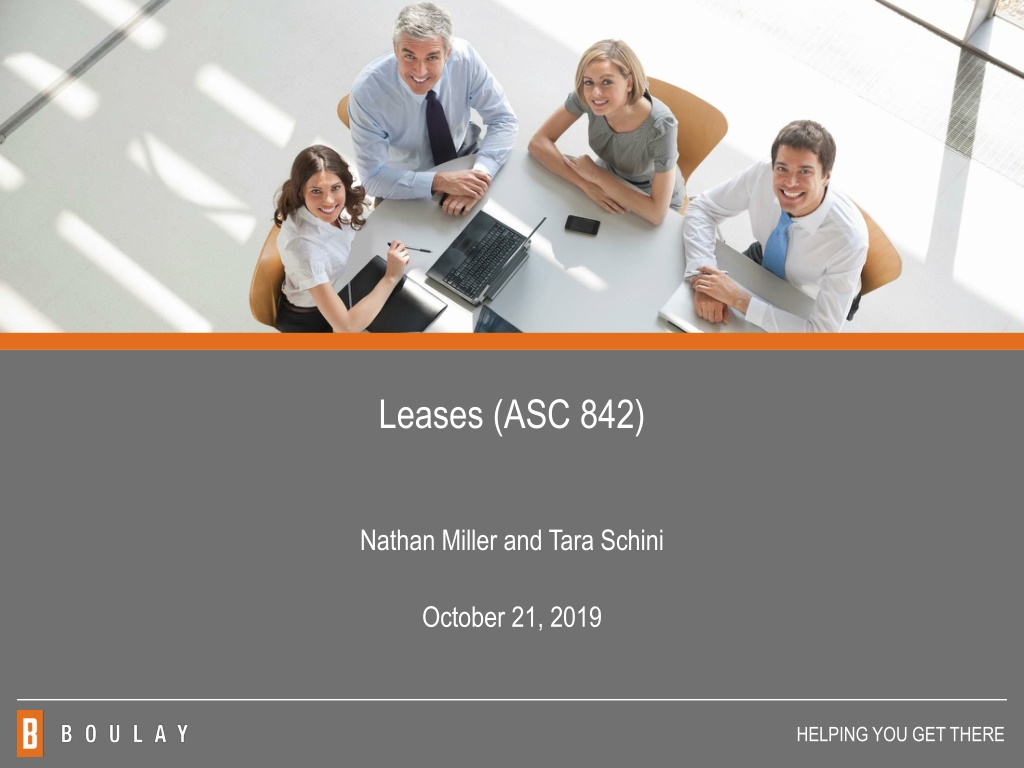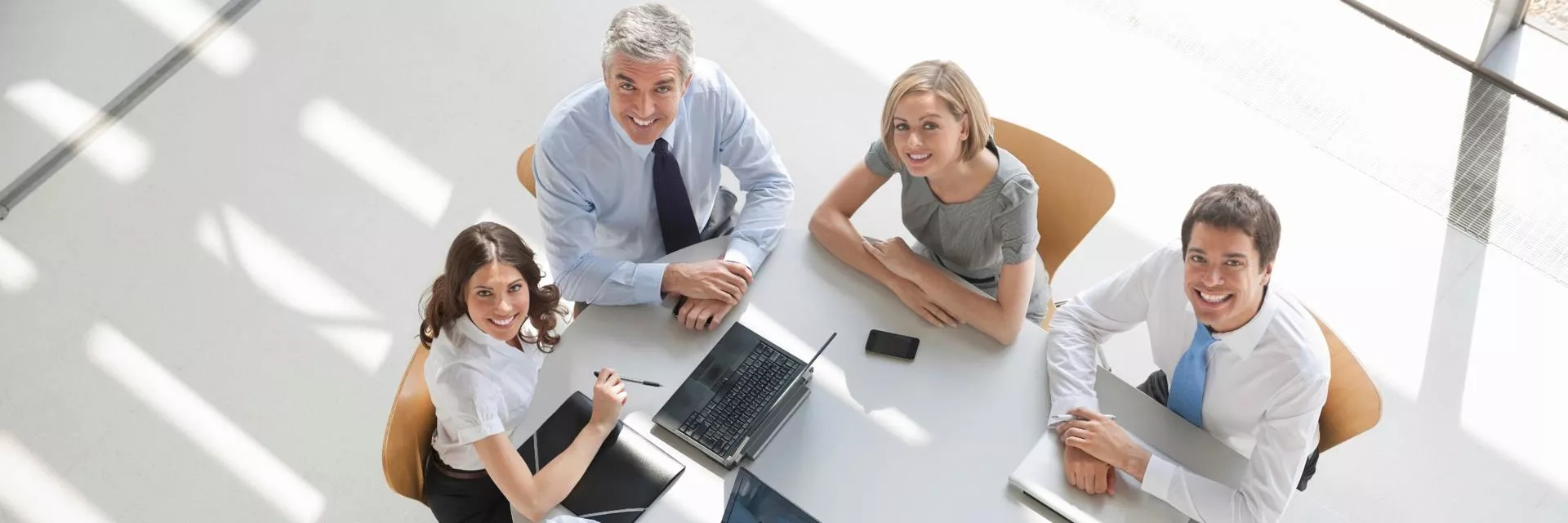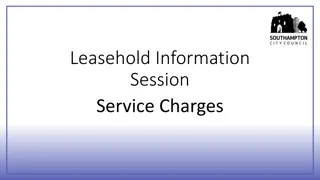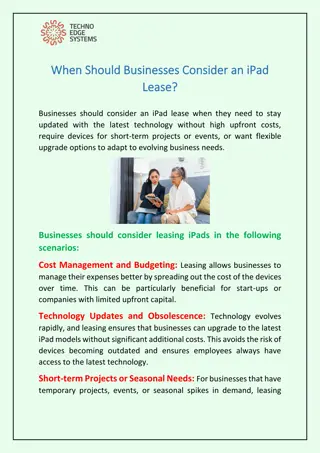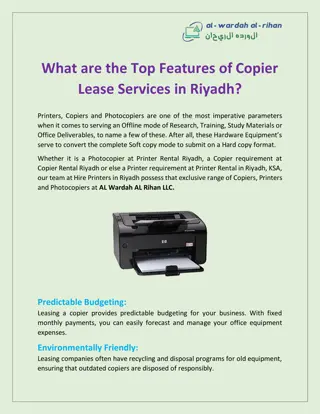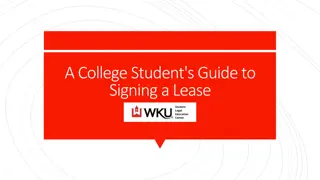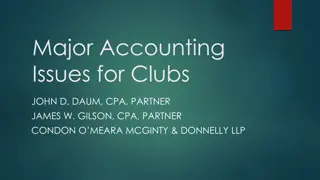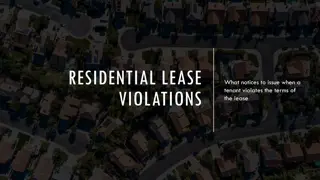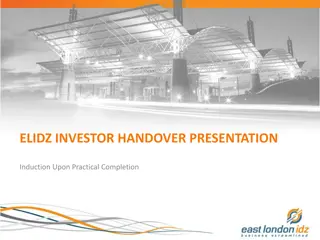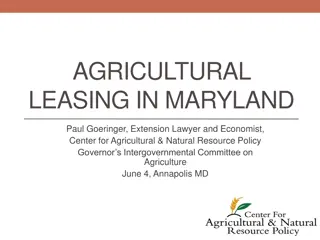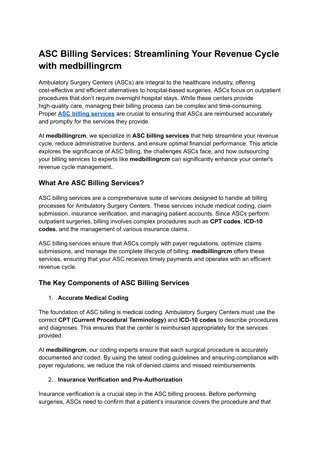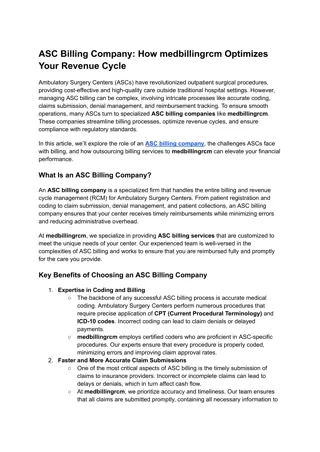New Lease Standard ASC 842
Overview of the new lease standard ASC 842, including accounting treatment, effective dates, lease classification, and definitions. Explore key changes and implications for entities with operating leases. Helpful insights for navigating the transition to the new leasing standard.
Download Presentation

Please find below an Image/Link to download the presentation.
The content on the website is provided AS IS for your information and personal use only. It may not be sold, licensed, or shared on other websites without obtaining consent from the author. Download presentation by click this link. If you encounter any issues during the download, it is possible that the publisher has removed the file from their server.
E N D
Presentation Transcript
Leases (ASC 842) Nathan Miller and Tara Schini October 21, 2019 HELPING YOU GET THERE
Todays Agenda Overview of new lease standard Accounting for leases under new standards Examples Disclosure and transition Questions and answers HELPING YOU GET THERE 2
ASU 2016-02 ASU 2016-02, Leases Creates Topic 842, Leases, in the FASB Codification Supersedes FASB ASC 840, Leases Applies only to leasing of property, plant and equipment (excludes intangibles, natural resources, inventory, assets under construction) Entities that hold numerous equipment and real estate leases, in particular those with numerous operating leases, will be most affected by this new guidance Operating leases will now be recorded on the balance sheet as assets and liabilities Retains a distinction between finance and operating leases HELPING YOU GET THERE 3
Effective Date Effective Date for Calendar-Year End Companies Public Business Entities Private Company, NPOs Early adoption? 2019 and interim periods within that year 2020 and interim periods in 2021 Yes Potential Deferral for Private Companies The FASB issued Proposed ASU 2019-750 in August 2019. This proposed ASU would defer the effective date of the new leasing standard by one year. HELPING YOU GET THERE
Lease Accounting Overview Type of Lease Balance Sheet Right-of-Use (ROU) Asset Lease Liability Right-of-Use (ROU) Asset Lease Liability Income Statement Amortization Expense Interest Expense Straight-Line Lease Expense Cash Flow Statement Principal Financing Interest Operating Finance Operating Operating Balance Sheet Presentation Cannot present finance and operating lease asset and liability amounts within the same line items. Must break out each separately on the face of the balance sheet or in the notes. Balance Sheet Classification: ROU assets will be classified as noncurrent (consistent with fixed assets) Lease liabilities will be classified into current and noncurrent portions HELPING YOU GET THERE
Definition of a Lease A lease is a contract, or part of a contract, that conveys the right to control the use of identified property, plant, or equipment (an identified asset) for a period of time in exchange for consideration. HELPING YOU GET THERE
Identified Asset Asset can be explicitly or implicitly identified Concept of an embedded lease Need to look at agreements for implicitly identified assets Supplier does not have substantive substitution rights. Two conditions must exist within the contract in order for a supplier s substitution rights to be considered substantive: Supplier has the practical ability to substitute alternative assets throughout the period of use Supplier would benefit economically from the exercise of its right to substitute the asset HELPING YOU GET THERE
Right to Control Use of the Asset Power Criterion The customer has the right to direct the use of the asset; and Economic Criterion The customer has the right to obtain substantially all the economic benefits from using the asset HELPING YOU GET THERE
Right to Control Use of the Asset An entity has the right to direct the use of the asset throughout the period of use in either of the following situations: The entity has the right to direct how and for what purpose the asset is used throughout the period of use The decisions about how and for what purpose the asset will be used are predetermined and at least one of the following conditions exist: The entity has the right to operate the asset (or direct other to operate) throughout the period of use without the supplier having the right to change those operating instructions The customer designed the asset (or specific aspects of it) in a way that predetermines how and for what purpose the asset will be used throughout the period of use HELPING YOU GET THERE
Protective Rights Contract may include terms and conditions designed to protect the supplier s interest in the asset or other assets, to protect its personnel, or to ensure the supplier s compliance with laws or regulations. Protective rights typically define the scope of the customer s right of use but do not, in isolation, prevent the customer from having the right to direct the use of an asset. HELPING YOU GET THERE
Cargo Ship Example Customer enters into a contract with a ship owner (Supplier) for the transport of cargo from Rotterdam to Sydney on a specified ship. The ship is explicitly specified in the contract, and the Supplier does not have substitution rights. The cargo will occupy substantially all of the capacity of the ship. The contract specifies the cargo to be transported on the ship and the dates of pickup and delivery. Does the contract contain a lease? HELPING YOU GET THERE
Cargo Ship Example (continued) There is an identified asset. The ship is explicitly specified in the contract, and the Supplier does not have the right to substitute that specified ship. Customer has the right to obtain substantially all of the economic benefits from use of the ship over the period of use. Its cargo will occupy substantially all of the capacity of the ship, thereby preventing other parties form obtaining economic benefits from use of the ship. However HELPING YOU GET THERE
Cargo Ship Example (continued) Customer does not have the right to control the use of the ship because it does not have the right to direct its use. Customer does not have the right to direct how and for what purpose the ship is used. How and for what purpose the ship will be used are predetermined in the contract. Customer has no right to change how and for what purpose the ship is used during the period of use. Customer has no other decision-making rights about the use of the ship during the period of use and did not design the ship. Customer has the same rights regarding the use of the ship as if it were one of multiple customers transporting cargo on the ship. This contract does not contain a lease. HELPING YOU GET THERE
Aircraft Example Customer enters into a contract with an aircraft owner (Supplier) for the use of an explicitly specified aircraft for a two-year period. The contract details the interior and exterior specifications for the aircraft. There are contractual and legal restrictions in the contract on where the aircraft can fly. Subject to those restrictions, Customer determines where and when the aircraft will fly, and which passengers and cargo will be transported on the aircraft. Supplier is responsible for operating the aircraft, using its own crew. Customer is prohibited from hiring another operator for the aircraft or operating the aircraft itself during the term of the contract. Supplier is permitted to substitute the aircraft at any time during the two-year period and must substitute the aircraft if it is not working. Any substitute aircraft must meet the interior and exterior specification in the contract. There are significant costs involved in outfitting an aircraft in Supplier s fleet to meet Customer s specifications. Does the contract contain a lease? HELPING YOU GET THERE
Aircraft Example (continued) There is an identified asset. The aircraft is explicitly specified in the contract, and although Supplier can substitute the aircraft, its substitution right is not substantive. Supplier s substitution right is not substantive because of the significant costs involved in outfitting another aircraft to meet the specification required by the contract such that Supplier is not expected to benefit economically from substituting the aircraft. Customer has the right to control the use of the aircraft throughout the two-year period of use because: Customer has the right to obtain substantially all of the economic benefits from use of the aircraft over the two-year period of use . Customer has exclusive use of the aircraft throughout the period of use. Customer has the right to direct the use of the aircraft. The restrictions on where the aircraft can fly define the scope of Customer s right to use the aircraft. Within the scope of its right of use, Customer makes the relevant decisions about how and for what purpose the aircraft is used throughout the two-year period of use because it decides whether, where, and when the aircraft travels as well as the passengers and cargo it will transport. Customer has the right to change these decisions throughout the two-year period of use. HELPING YOU GET THERE
Aircraft Example (continued) Although the operation of the aircraft is essential to its efficient use, Supplier s decisions in this regard do not give it the right to direct how and for what purpose the aircraft is used. Consequently, Supplier does not control the use of the aircraft during the period of use, and Supplier s decisions do not affect Customer s control of the use of the aircraft. This contract contains a lease. HELPING YOU GET THERE
Network Services Example Customer enters into a contract with a telecommunications company (Supplier) for network services for two years. The Contract requires Supplier to supply network services that meet a specified quality level. To provide the services, Supplier installs and configures servers at Customer s premises; Supplier determines the speed and quality of data transportation in the network using the servers. Supplier can reconfigure or replace the servers when needed to continuously provide the quality of network services defined in the contract. Customer does not operate the servers or make any significant decisions about their use. Does the contract contain a lease? HELPING YOU GET THERE
Network Services Example (Continued) The contract does not contain a lease. The contract is a service contract in which Supplier uses the equipment to meet the level of network services determined by Customer. Customer does not control the use of the servers because only decision-making rights relate to deciding on the level of network services (the output of the servers) before the period of use the level of network services cannot be changed during the period of use without modifying the contract. HELPING YOU GET THERE
Network Services Example (Continued) Even though Customer produces the data to be transported, that activity does not directly affect the configuration of the network services and, thus, it does not affect how and for what purpose the servers are used. Supplier is the only party that can make decisions about the use of the servers during the period of use. Supplier has the right to decide how data are transported using the servers, whether to reconfigure the servers, and whether to use the servers for another purpose. Supplier controls the use of the servers in providing network services to Customer. There is no need to assess whether the servers are identified assets because Customer does not have the right to control the use of the servers. HELPING YOU GET THERE
Server Example Customer enters into a contract with an information technology company (Supplier) for the use of an identified server for three years. Supplier delivers and installs the server at Customer s premises in accordance with Customer s instructions and provides repair and maintenance services for the server, as needed, throughout the period of use. Supplier substitutes the server only in the case of malfunction. Customer decides which data to store on the server and how to integrate the server within its operations. Customer can change its decisions in this regard throughout the period of use. Does this contract contain a lease? HELPING YOU GET THERE
Server Example (continued) Customer has the right to use the server for three years. There is an identified asset: The server is explicitly specified in the contract. Supplier can substitute the server only if it is malfunctioning. HELPING YOU GET THERE
Server Example (continued) Customer has the right to control the use of the server throughout the three-year period of use because: Customer has the right to obtain substantially all of the economic benefits from use of the server over the three-year period of use. Customer has exclusive use of the server throughout the period of use. Customer has the right to direct the use of the server. Customer makes the relevant decisions about how and for what purpose the server is used because it has the right to decide which aspect of its operations the server is used to support and which data it stores on the server. Customer is the only party that can make decisions about the use of the server during the period of use. This contract contains a lease. HELPING YOU GET THERE
Lease Steps 1. Determine whether a contract contains a lease 2. Identify the separate lease components within the contract 3. The consideration in the contract is allocated to each separate lease component and nonlease component of the contract HELPING YOU GET THERE
Identify the Separate Lease Components Consider the right to use an underlying asset to be a separate lease component if both of the following criteria are met: The lessee can benefit from the right of use either on its own or together with other resources that are readily available to the lessee. The right of use is neither highly dependent on nor highly interrelated with the other right(s) to use underlying assets in the contract HELPING YOU GET THERE
Components of a Contract Category Description Accounting Lease Components Right to use underlying asset: Each vehicle in a fleet lease Land, building, and garage Include in ROU lease asset and lease liability (B/S) Nonlease Components Goods and services provided to the lessee that are separate from the right to use the asset: Maintenance, security, cleaning Executory contract expense as incurred (P/L) Items Outside the Lease (Not Components) Activities that do not transfer goods or services to the lessee: Property taxes, insurance Allocate to lease and nonlease components HELPING YOU GET THERE
Allocate the Consideration Allocate the consideration in the contract on a relative standalone price basis to the separate lese components and the nonlease components of the contract. If observable standalone prices are not readily available, estimate the standalone selling prices by maximizing the use of observable information. A residual estimation approach may be appropriate. HELPING YOU GET THERE
Optional Election Option to elect an accounting policy to bundle a nonlease component with its related lease component. Election made by class of asset (e.g. automobiles, heavy machinery, land, buildings, etc.) Pros Avoids need to estimate standalone selling prices. Cons Increases the initial lease asset and liability recognized. HELPING YOU GET THERE
Lease Term Noncancelable period for which the lessee has the right to use the underlying asset, adjusted for: Lessee-Controlled Options Extension / renewal period(s), if lessee is reasonably certain to extend Lease termination options, if lessee is reasonably certain to exercise (or not exercise) Lessor-Controlled Options Assume that lessor will trigger the extension / renewal option Also assume that lessor will choose to not terminate the lease Reasonably Certain = Reasonably Assured (more certain than probable a very high threshold) HELPING YOU GET THERE
Reasonably Certain There must be a compelling economic reason in order to conclude that an option to renew (or not to exercise a termination option) is reasonably certain. Factors to consider include: Type of Factor Examples Contract-Based High termination penalty, below market rents in renewal period Asset-Based Location of the asset, costs associated with lost production, significant leasehold improvements that would be lost Entity-Based Asset is critical to entity s operations Market-Based Laws and regulations, market rentals for a comparable asset HELPING YOU GET THERE
Lease Classification A lease that meets any of the following criteria is a finance lease. Transfer of Ownership The lease transfers ownership of the underlying asset to the lessee by the end of the lease term or the lessee is reasonably certain to exercise (bargain purchase option) Economic Life Test The lease term is for the major part of the remaining economic life of the underlying asset (Current std - Lease is greater than 75% of the life) Present Value Test The present value of lease payments and any residual value guaranteed by the lessee that is not already reflected in the lease payments equals or exceeds substantially all of the fair value of the underlying asset (Current std - PV of lease payments is greater than 90% of the FMV) Specialized Asset (New criterion) The underlying asset is of such a specialized nature that it is expected to have no alternative use to the lessor at the end of the lease term A lease that meets none of these criteria is an operating lease. HELPING YOU GET THERE
Short-Term Leases Policy Election A lease that, at the commencement date, has a lese term of 12 months or less and does not include an option to purchase the underlying asset that the lessee is reasonably certain to exercise. Lessees may elect an accounting policy to not recognize lease assets and lease liabilities for short-term assets (by class of asset). Instead, lessees simply record lease expense on a straight-line basis over the term of the short-term lease HELPING YOU GET THERE
Lease Payments Lease payments consist of: Fixed payments (including in-substance fixed payments) Variable lease payments that depend on an index (e.g. CPI) or rate The exercise price of an option to purchase the underlying asset if the lessee is reasonably certain to do so Penalties for terminating the lease if the lease term reflects the lessee exercising an option to terminate the lease Amounts probable of being owed by the lessee under a residual value guarantee Less lease incentives paid or payable to the lessee HELPING YOU GET THERE
Lessee Accounting Recognition Finance lease Operating lease Lease Liability - Initial and subsequent measurement Present value of unpaid lease payments ROU Asset Initial measurement Initial measurement of the lease liability + Initial direct costs + Prepaid lease payments - Lease incentives received ROU Asset Subsequent measurement Beginning balance - Accumulated amortization - Accumulated impairment losses Beginning balance - Accumulated amortization Timing of when lease incentives are received is important. If received before lease commencement, will reduce ROU Asset only. If received after commencement, will reduce lease liability and ROU Asset. HELPING YOU GET THERE
Discount Rate Use rate implicit in the lease, but if that cannot be readily determined, use the lessee s incremental borrowing rate Incremental borrowing rate equals what a lessee would have to pay for a collateralized borrowing over a similar term of the lease Private companies can elect to use a risk-free rate (if elected, must be applied to all leases) HELPING YOU GET THERE
Implicit Rate Lessees typically will not be able to determine the implicit rate to do so, the lessee would need to know either the rate used by the lessor or all of the following: The lease payments The fair value of the asset at inception Lessor s expected residual value for the leased asset (cannot use market databases as estimate for lessor s expectation) Lessor s initial direct costs Lessor s investment tax credits HELPING YOU GET THERE
Incremental Borrowing Rate The rate of interest that a lessee would have to pay to borrow on a collateralized basis over a similar term an amount equal to the lease payments in a similar economic environment. Cannot use unsecured borrowing rate Determine what collateral the lender would demand in order to lend the lease payments to the lessee Collateral is not restricted to leased asset Rate should be based on amortizing debt (not bullet debt) HELPING YOU GET THERE
Related Party Leases Classify leases between related parties based on the legally enforceable terms and conditions of the lease. Do not classify the lease based on an evaluation of its economic substance. Excerpt from ASC 842-10-55-12: Leases between related parties should be classified in accordance with the lease classification criteria applicable to all other leases on the basis of the legally enforceable terms and conditions of the lease. In the separate financial statements of the related parties, the classification and accounting for the leases should be the same as for leases between unrelated parties. HELPING YOU GET THERE
Initial Direct Costs Include Exclude Commissions Payments made to an existing tenant to incentivize that tenant to terminate the lease Legal fees Costs of evaluating the prospective lessee s financial conditions Costs of negotiating lease terms and conditions General overheads The new standard s definition of Initial Direct Costs is narrower than legacy US GAAP. Only include incremental costs of a lese that would not have been incurred if the lease had not been obtained (very similar to ASC 606 and treatment of costs to obtain a customer). HELPING YOU GET THERE
Day 1 Accounting - Example Lease term is for 3 years Payment Schedule: $100,000 at the end of Year 1 $105,000 at the end of Year 2 $115,000 at the end of Year 3 Discount rate is 6.8172% Present value of lease payments is $280,000 Lessee s initial direct costs are $15,000 HELPING YOU GET THERE
Day 1 Accounting Example (contd) Lease Liability $280,000 Being the present value of lease payments, discounted at 6.8172% + $15,000 Initial direct costs + $0 Prepayments of lease payments - $0 Receipts of lease incentives Right of Use Asset $295,000 Being the $280,000 lease liability Lessee records the lease on Day 1: Dr. Right of Use Asset $295,000 Cr. Lease Liability $280,000 Cr. Cash/Payables (initial direct costs) 15,000 HELPING YOU GET THERE
Day 2 Accounting Operating Lease In an operating lease, Lessee will: Accrete the carrying value of the lease liability based on the discount rate Reduce the carrying value of the lease liability as the lessee makes lease payments Amortize the ROU asset over the lease term by the difference between the straight-line lease expense and the liability accretion Straight-line lease expense = the sum of the undiscounted lease payments and the initial direct costs, divided by the lease term Record variable lease payments, if any, in the period incurred HELPING YOU GET THERE
Operating Lease Example Compute straight-line lease expense: = ($100,000 + $105,000 + $115,000 lease payments + $15,000 IDC)/ 3 years = $111,667 HELPING YOU GET THERE
Operating Lease Example Year Lease Liability Beg Balance Interest @ 6.8172% End Balance Payments 1 280,000 19,088 100,000 199,088 2 199,088 13,572 105,000 107,660 3 107,660 7,340 115,000 - HELPING YOU GET THERE
Operating Lease Example Year Right of Use Asset Beg Balance End Amort Balance 1 295,000 92,579 202,421 2 202,421 98,095 104,326 3 104,326 104,326 - HELPING YOU GET THERE
Operating Lease Example Journal Entries In Year 1: Dr. Lease expense Cr. Lease liability Dr. Lease liability Cr. Cash (Accretion = $280,000 opening lease liability x 6.8172% disc rate) 19,088 100,000 19,088 100,000 Dr. Lease expense Cr. Right of Use Asset (Amortization = $111,667 straight-line lease expense - $19,088 accretion) 92,579 92,579 HELPING YOU GET THERE
Operating Lease Example - Summary Year 1 Year 2 Year 3 Total Accretion component 19,088 13,572 7,340 40,000 ROU amortization component 92,579 98,095 104,326 295,000 Total Expense 111,667 111,667 111,666 335,000 Year 1 Year 2 Year 3 Total Operating cash flows 115,000 105,000 115,000 335,000 Financing cash flows - - - - Total cash flows 115,000 105,000 115,000 335,000 HELPING YOU GET THERE
Lessee Disclosures - Overall The objective of the disclosure requirements is to enable users of the financial statements to assess the amount, timing, and uncertainty of cash flows arising from leases. To achieve that objective, a lessee shall disclose qualitative and quantitative information about all of the following: Its leases The significant judgments made in applying the requirements of Topic 842 to those leases The amounts recognized in the financial statements relating to those leases HELPING YOU GET THERE
Lessee Disclosures - Leases A lessee shall disclose all of the following: Information about the nature of its leases, including: A general description of those leases. The basis and terms and conditions on which variable lease payments are determined. The existence and terms and conditions of options to extend or terminate the lease. A lessee should provide narrative disclosure about the options that are recognized as part of its right-of-use assets and lease liabilities and those that are not. The existence and terms and conditions of residual value guarantees provided by the lessee. The restrictions or covenants imposed by leases, for example, those relating to dividends or incurring additional financial obligations. HELPING YOU GET THERE
Lessee Disclosures Leases (cont.) Information about significant assumptions and judgments made in applying the requirements of this Topic, which may include the following: The determination of whether a contract contains a lease The allocation of the consideration in a contract between lease and nonlease components The determination of the discount rate for the lease HELPING YOU GET THERE
Lessee Disclosures Leases (cont.) Information about leases that have not yet commenced but that create significant rights and obligations for the lessee, including the nature of any involvement with the construction or design of the underlying asset. HELPING YOU GET THERE
